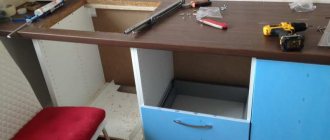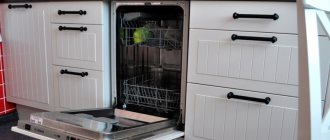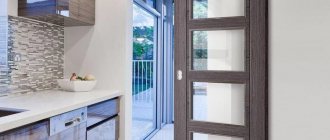Kitchen design
0
15 667
Share
With a wide range of kitchen appliances to choose from, you can do without a classic stove. This option is acceptable for a young couple who rarely eats at home and lives in a studio apartment.
- Which stove to choose: electric or gas?
- Glass ceramics
- Slab size
- Ceiling
- Installation of a built-in kitchen
- Design and interior in small spaces
- Small studio apartment
- One-room apartments
The family requires the presence of a stove, even in a small kitchen. It will take up less space, kitchen appliances advertised in commercial breaks.
If anyone thinks otherwise, let’s estimate together how many gadgets will fully replace a conventional stove and oven:
- Microwave.
- Air fryer.
- Multicooker.
- Bread maker.
- Toaster.
- Electric Turk.
- Electric kettle.
Now imagine where all this should be located, how much it will cost and what the electricity bills will be. It turns out that the stove takes up less space, costs less money and consumes less electricity. Therefore, the right choice is a kitchen with a stove. A few photos of the kitchen with the stove will help you verify this.
Determining the location of household appliances
The functionality, ease of use, and service life of household appliances depend on the correct location. A kitchen set with a built-in stove is suitable for those who have already decided on the location of the equipment and ordered furniture taking into account the characteristics of the room. Conventionally, the space in the kitchen can be divided into three zones:
- Water. This includes a sink, washing machine, dishwasher, and refrigerator.
- Hot. Stove, all household appliances designed for thermal exposure.
- Working. Surface for preparing food for cooking, frying, baking.
Designers propose the triangle rule, which will allow for optimal distribution of household appliances. But this option is only possible in medium and large rooms. With minimal dimensions, preference is given to a linear layout. A kitchen set with a stove must include an exhaust hood; it is prohibited to install a refrigerator or dryer next to the stove.
The location of the stove in the kitchen is often dictated by the placement of communications. But often the design requires moving household appliances. The placement is influenced by the configuration of the kitchen, the power and potential danger of the household appliance, and the open “neighborhood” with another room. Below is a photo of a kitchen with hoods above the stove, the design of which is closer to Provence.
Selecting seeds for a greenhouse
It is very important to choose the exact variety of tomato that will be suitable for the greenhouse. There are special “greenhouse” varieties that should be given preference first of all. They grow well in a greenhouse and produce a high-quality and rich harvest. These include:
- Bull's heart. This species is characterized by very high productivity, large and pleasant-tasting fruits.
– Miracle of the Earth is the most ideal variety for greenhouse conditions.
– Samara has sweet and juicy fruits. This variety grows well in a polycarbonate greenhouse.
– Long keeper, with proper care, can produce a harvest of up to 4 kilograms per bush.
– Moneymaker is an early variety that can be planted in a greenhouse in March and harvested in early summer.
– Dina is an excellent variety for greenhouses, which produces a yield of up to 5 kilograms per bush.
There are also more exotic varieties.
Hood placement
A range hood is a must-have item in the kitchen, especially in cases where there is a living room or bedroom in the same room. The hood is often placed above the hob, the main thing is to maintain the correct distance.
Important! Direct hood can be installed at a height of up to 85 cm.
They also take into account the design of the room, the power of the device and the height of the person who will use the hob more often. The installation is influenced by the location of the connection to the electrical network and the method of venting gas into the ventilation shaft. This can be either an outlet for a stove in the kitchen or a separate power source. The device must completely cover the stove to ensure minimal spread of odors. Important things to consider:
- You can hang it higher than normal, but not lower;
- Only built-in models can be mounted in a hanging cabinet;
- the hood should not interfere with the cooking process;
- The more powerful the device, the higher it can be placed.
The dome device is attached to the wall, the corner device can be installed in the corner. A fireplace hood is often installed according to the same principle as a dome hood. The island is attached to the ceiling. The placement of the hood also depends on how to place the stove in the kitchen . It is also possible to install the headset without a household appliance. Below is a photo of a kitchen design without a hood above the stove .
Preparing tools
To install built-in equipment yourself, you will need the following tools:
- Construction level - needed in order to fix the hob perfectly evenly;
- a measuring device and a pencil - useful for marking the tabletop;
- electric jigsaw for “cutting” the hole;
- fastening elements - selected based on the model of equipment;
- a certified steel hose (up to 3 meters long) is an indispensable element when supplying gas;
- gas winding - will prevent fuel leakage at the junction of the hose and the gas pipeline;
- silicone sealant - will protect furniture from destruction by moisture and fungi.
Article on the topic: Has anyone bought an air conditioner in Poland?
How to place the stove
The stove is a potentially dangerous household device and requires special attention during installation. An electric stove can cause a short circuit; a gas stove is explosive. “refrigerator-sink-stove” is influenced by . It is not recommended to install the stove under a window or near a windowsill. Do not install it near a sink, as drops of water falling on a hot surface increase the risk of burns. Designers recommend:
- install a protective screen made of easy-to-clean material;
- choose a set with a fire-resistant coating;
- wall plates for the kitchen must withstand temperature changes;
- place a kitchen screen over the stove , maintaining the distance.
The stove must be positioned so that it is located next to the gas distribution and ventilation compartment. Furniture should not tightly close the valve that shuts off the gas. It is forbidden to place the stove next to the refrigerator. Below is a photo of a stove in a kitchen interior .
Furniture in the interior of a small kitchen
The compact dimensions of the room do not mean at all that the furniture should be a smaller copy of itself. An abundance of cabinets, tables and shelving clutter the kitchen, but with the right choice of interior elements and, most importantly, their quantity, you can achieve a feeling of spaciousness without sacrificing functionality.
At the same time, it should be remembered that in the interior it is not so much each individual element that is important, but their combination. For example, a refrigerator, stacked cabinets and other tall objects create a vertical perspective, which should be correctly decorated with color.
In some cases, it will be appropriate to divide the interior horizontally into two parts at the height of an adult’s neck. The lower part can be painted in a darker color, and the upper part, respectively, in a lighter color.
The color of the furniture should be combined and harmonize with the color of the walls, refrigerator and gas stove. In a cramped space, you should not create contrast; it is much better when massive interior elements practically merge with the walls.
When choosing furniture for a compact kitchen, you should give preference to simple and unpretentious interior items. Massive column cabinets with carved facades will only aggravate the problem of lack of free space. Furniture should include as many light and “airy” elements as possible: transparent facades, glass shelves, shallow open niches. Glass can also be used as a tabletop for a dining table, especially since the modern market offers a lot of options for furniture of this kind.
It would be advisable to use wall cabinets with a column of increased height. They differ quite a bit from standard analogues, but they allow you to use precious centimeters more efficiently.
Where to place the oven
A kitchen with a built-in stove may have a separate oven or oven. It is advisable to place household appliances above the countertop; this arrangement ensures safety and ease of use.
Important! To save space, you can place the oven in a cabinet or mount it on an island.
It is prohibited to place close to the refrigerator or install closer than 10 cm to the wall. The oven should open easily; the owner could easily disconnect the device from the network or turn off the gas. A kitchen with a stove in the middle often includes installing an oven underneath in a cabinet. The photo below shows an example of how to integrate a stove into a kitchen unit that has a separate oven.
Gas supply to residential buildings
The use of gas for heating residential buildings and heating water in the warm season has become possible due to the relatively low cost of this fossil.
After undergoing primary processing, it is cleared of mechanical impurities and chemical additives. Thanks to a wide network of gas pipelines, it can be obtained in any locality and delivered to every home.
Scope of application of natural gas in residential buildings:
- Cooking food
- Heating water in the absence of central hot water supply
- Heating in the cold season
Cooking food. Most homes have gas stoves for cooking. They gained popularity not so much from the price of the stoves, but from the cost of fuel, ease of connection, and uninterrupted supply.
The advantages of gas stoves include ease of operation and low cost of maintenance and repair.
Heating water. The use of natural fuel to heat water in homes became popular in the middle of the last century.
A huge advantage of these systems was the presence of an already supplied source of natural gas to apartments and houses.
A serviceable and adjusted column provided stable hot water for the needs of each consumer in the absence of a central hot water supply.
Heating. This type of gas use has found wide application in private homes where central heating is not practical.
Each consumer, having an existing gas supply system in their arsenal, installed a heating boiler for their needs.
Depending on the area of the house, a boiler was purchased and a heat distribution system was installed throughout the house.
The consumer himself chose the temperature in his home depending on weather conditions and, accordingly, gas consumption.
How to maintain functionality
The stove in the kitchen interior is part of the design. It should be in harmony in tone, color, texture. But it is important to maintain functionality:
- access to household appliances should be free;
- No other devices or flammable objects should be placed nearby;
- the hood should not interfere with cooking;
- When cooking, the owner's hands should not rest against side cabinets or low shelves.
A kitchen set without a sink and stove requires their free placement, but it is not recommended to install them next to each other. The work surface is installed either closer to the stove, or at an equidistant distance from the stove to the sink. It is also possible to install a headset without a device.
A kitchen set with a stove must take into account the location of other household appliances. Take into account the space for opening doors, the location of electrical outlets, sewerage outlets and water supply.
Important! All taps, sockets and valves must be freely accessible.
Below is a photo of a kitchen without a hood above the stove, the design of which is closer to the loft style. But there are other options. Some housewives choose a design without a stove or hob. You can replace a bulky household appliance with an electric kettle, a multicooker, or a separate oven. You can use a microwave oven for heating.
Installation of Gefest CH 1210 hob
When installing the table, of course, it is necessary to take into account the presence and size of the supply gas and electrical communications.
| Rice. 4. Bottom view of the hob with an electrical cord and an outlet for connecting a gas hose |
Marking the countertop for the hob
We start again with markings, using a pencil to outline the outline of the opening on the tabletop in accordance with Figure 5.
Related article: How to melt brass on a gas stove
What you need to consider when marking the contour for the Gefest CH 1210 hob
When marking, you need to take into account (Figure 5):
When installing the hob, it is necessary to ensure minimum air gaps according to Figure 7.
| Rice. 7. Minimum air gaps |
Cut out the outline for installing the hob
During the cutting process, we hold the part of the tabletop to be removed from below to avoid its premature fall and chipping of the decorative coating. No additional ventilation holes are required.
| Rice. 8. The cutout for the hob is ready |
Installing mounting brackets
We place and secure the mounting brackets so that the top edge of the bracket is flush with the surface of the tabletop.
To avoid cracking the countertop, do not tighten the screws without first drilling holes with a diameter of 2.5 to 3-4 mm.
| Rice. 9. Installation of fasteners |
By the way, this is a very simple and convenient way to install a hob; before this we encountered a more “hemorrhoids” method.
| Rice. 10. Fastening the hob using staples to the sides of the chipboard oven body |
Along the edge of the inside of the table we glue the table seal for a tight and airtight fit; the seal is similar to that used for installing the sink.
Next, carefully insert the hob into the opening and secure it with four screws and washers.
Why an induction hob is better than others
Advantages and disadvantages of an induction hob compared to gas and electric panels. Economics of using an induction panel. Did you know that there are hobs combined with hoods?
Gas hose connection
The gas hose must be connected by specialists, do not forget about this!
For installation, we bought a bellows hose, a dielectric coupling and an installation kit.
| Rice. 11. Everything we originally bought to connect the gas hob |
| Rice. 12. Contents of the installation kit |
Gas hose connection requirements
When connecting, the following requirements must be met:
Check the tightness of the connections in accordance with the technological instructions of the gas supply organization.
Bellows gas hose
Bellows gas hose is safer and more durable than rubber gas hoses, with references to lifespans of up to 25 years.
Bellows hoses are produced from stainless steel, at the ends of the hose there are threaded fittings with paronite gaskets. The hose bends easily, withstands pressure up to 6 atmospheres and temperatures from -50 to +200 degrees C.
But bad luck, it turned out that the bellows hose cannot be immediately connected to the gas pipe and a dielectric coupling cannot be installed; again, I had to go to a hardware store and buy a connecting coupling. Gas workers checked - everything is secure and there is no gas leak.
| Rice. 13. It turned out to be impossible to immediately connect the bellows hose to the gas pipe using a fitting; a coupling is needed |
| Rice. 14. The bellows hose is connected using a coupling |
| Rice. 15. Connect the bellows gas hose through a fitting to the gas supply to the hob. A little further down the view is a plate with which the hob is fixed to the cutout in the countertop |
| Rice. 16. Hob installed |
| Rice. 17. The gas pipe and bellows hose are hidden behind the box |
Watch a video about the results of installing a gas hob
Designer recommendations
shows a kitchen without a hood over the stove , which does not lose functionality. The more household appliances, the more difficult it is to arrange them. Designers recommend saving space and choosing combined models. Thus, a kitchen with a separate stove may exclude the installation of an oven, since the oven may include an oven. Other tips:
- install the stove and hood strictly according to the rules;
- if necessary, you can install an additional lighting source above the stove;
- take into account the location of the microwave and oven.
It is important to maintain the ergonomics of the kitchen space, safety of operation and convenience while working in the kitchen. Reliable extension cords will provide power throughout the kitchen. If possible, portable electrical appliances, an oven or microwave can be installed in niches or on shelves.
Installation and connection process
Installing the hob in the prepared window is simple. We lower the panel into the hole . We align its position using a measuring tool.
Using special brackets and self-tapping screws, which the manufacturer supplies in the kit, we fix it from below. You can use a seal around the perimeter of the device that is being installed. It is usually supplied with the product.
We glue a special aluminum tape onto a degreased and dried surface and press it slightly. A good sealant is also polyethylene tape for drywall, which is 30 mm wide. This becomes an obstacle to the path of debris and moisture under the surface that is being installed.
IMPORTANT! Before gluing, we check whether the thickness of the seal matches the internal depth of the panel sides. If the tape is thin, a gap will form. And moisture will get through it.
Next, you need to lay a solid strip around the perimeter of the cutout from the front of the cabinet. It is good if the seal protrudes 1 cm below the side. This is ideal.
We reinstall all the parts that were removed. We connect the energy carrier. We cut the gas panel into the gas main. We connect the electrical panel to the electrical network, which must be prepared in advance. It remains to test the technique in action.
Article rating:
How to build a regular gas stove into a countertop Link to the main publication Articles mentioning words:
Important Don't
Related publications
- How does a gas coffee machine work?
Dangerous properties of natural gas
Each of us, from school age, begins to be told about the need to carefully handle fire and household gas. However, not everyone knows what the consequences of leakage of this substance are.
For example, there is a widespread misconception that a person can be poisoned by household gas. This is impossible, because The natural gas supplied to homes is itself non-toxic. Death from leakage occurs due to asphyxiation. When gas molecules used in everyday life enter the lungs, they block access to oxygen. And the person dies, no longer able to breathe.
Natural gas is explosive. Once you smell it (more precisely, the smell of odorant), you need to stop using all electrical appliances, including those operating offline, and also not use open fire. Be sure to open all doors and windows, then call the gas service. These are measures to prevent an explosion from occurring when a dangerous gas concentration in a room is reached (5 - 15% of the total air mass). It is impossible to determine the level of gas pollution on your own, so it is better to play it safe and follow the recommendations. And also remember that the highest concentration of the substance in the room will be at the top, because Natural gas is almost 2 times lighter than air.
You can prevent dangerous consequences from gas used in everyday life by installing a special gas analyzer that will warn of a leak. And, of course, have a working ventilation system that will not allow high gas concentrations in the room.
What does natural gas consist of - gas composition
98% of natural gas consists of methane, and this amount varies slightly depending on where it is produced.
It also includes:
- Butane
- Propane
- Ethane
- Pentane
- Hexane
- The composition contains hydrogen sulfide, carbon dioxide, and water vapor.
To use gas in everyday life, it must have certain parameters, which are regulated by GOST 5542-2014 “Natural flammable gases for industrial and municipal purposes. Technical specifications In order to obtain the established parameters, the supplier purifies the product, removes excess impurities from the composition, and only after that can supply it to the market.
Gas cylinders used in everyday life
In addition to natural gas supplied through the central gas pipeline, liquefied gas is often used. Basically, it is propane-butane, which is obtained from oil refining. Other hydrocarbon mixtures are less common.
Liquefied natural gas is practically not used in everyday life. It is also rarely used in industrial plants due to the difficulty of keeping the substance in a liquid state. This requires greater pressure and thickness of the tank, which is significantly more expensive.
Liquefied propane-butane gas used in residential buildings has a high calorific value, which is a definite advantage. For example, the room will be heated longer when using a cylinder. At the same time, propane-butane gas is much more explosive than natural gas.
When deciding to switch to using liquefied gas cylinders, you should take into account that when connecting to the stove, the nozzles will need to be reconfigured or changed. The diameter of the hole in the nozzle regulates the amount and speed of the supplied gas. These values differ depending on the particular substance used due to differences in composition, and, consequently, properties and characteristics.
An unsuitable nozzle will lead to unnecessary gas leakage and soot marks on the dishes or a low-temperature flame. Both of these options mean increased utility costs due to increased fuel consumption.











